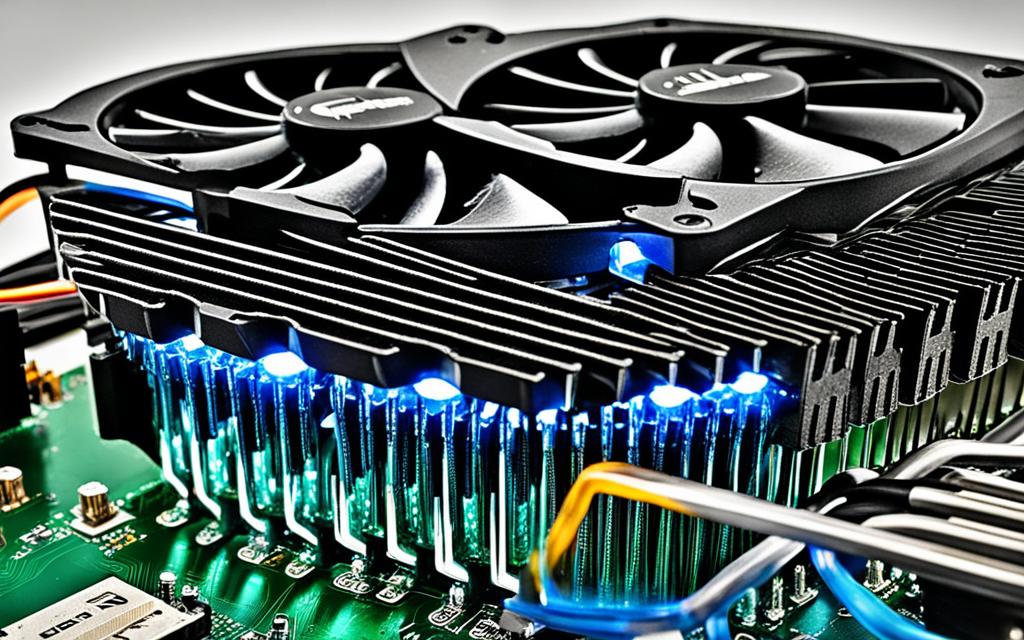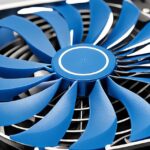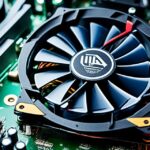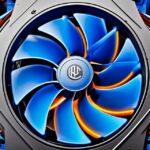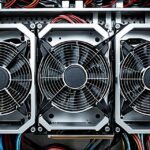Table of Contents
To find out the best way to cool your PC, you must get the fan direction right. How the fan moves impacts how well your PC stays cool. It’s crucial to check if the fan is pulling air in or pushing it out. You can figure this out by looking at the arrows on the fan or by checking the fan blades’ shape.
First up, look for the arrows on your fan’s casing. Many fans have these to show which way the air flows. These arrows make it clear and stop any mix-up about how to place the fan. Seeing these arrows means you know for sure which way the air’s meant to go1.
If there aren’t any arrows, don’t worry. Just check out the fan blades’ look. Fans usually have blades that curve to one side. The side where the blades curve more is where air comes in. The flatter side is where air goes out. By looking at the blades, you can work out the fan’s direction1.
Another way to tell is by looking at the motor brackets on the fan. Most of the time, PC fans are made to blow air towards these brackets. This helps keep the motor and other bits cool1.
It’s good to remember that not all fans are the same. Some are “reverse fans” and work differently from regular ones. If you can’t see any clear signs on the fan, it’s key to double-check. This stops any problems and makes sure your PC cools down well1.
Key Takeaways:
- Finding out which way your PC fan blows is key for great cooling.
- Look for arrows on the fan to know which way the air should flow1.
- Check the blades’ shape to figure out where air comes in and goes out1.
- Look at the motor brackets to see the fan’s design for blowing air1.
- Always check the fan’s direction if there aren’t any clear signs on it1.
How to Tell the Fan Direction with Arrows
Some case fans have arrows that show airflow direction. They’re found on the fan side with other marks. By knowing what these arrows mean, you can tell if the fan is for pulling in cool air or pushing out warm air.
These arrows guide you on airflow direction. The horizontal arrow shows fan blade spin direction. The vertical arrow shows where the air goes. Upwards means intake mode, and downwards means exhaust mode. Knowing this helps install fans right for the best cooling.
Not all fans have these arrow indicators. But, there are other ways to find out airflow direction. Look at the fan blades. If one side is curved outward and the other inward, air flows from the convex to the concave side.
Also, check where the fan connects to its motor. Usually, air blows out from this side. This helps you understand airflow direction too.
This resource offers more help on spotting fan direction. It includes advice on using tools for the right fan setup.
Data from2 underlines the value of fan direction arrows. It shows some fans have arrows for airflow direction. Fans can spin fast, like 2000 revolutions per minute. Tests prove the intake side of a fan is cooler than the exhaust side on a case chassis. This info stresses the need for correct fan direction for cooling and performance.
Determining Fan Direction without Arrows
Not all PC fans have arrows showing airflow direction3. But, you can still figure it out. One way is to look at how the fan blades curve. This can tell us which side pulls air in and which pushes it out3.
Look at the fan blades closely. If they curve away and look convex, that’s the intake side3. It pulls cool air in. If the blades curve towards you and appear concave, that’s the exhaust side3. It pushes warm air out, away from the computer3.
Knowing how the blades curve is key for better airflow in your PC. It helps you set up your fans properly. This ensures your computer stays cool and runs well3.
To find fan direction without arrows, the blade shape is a clue. Convex means intake, concave means exhaust3. Learning this helps improve your PC’s performance and life3.
| Methods for Determining Fan Direction without Arrows | Percentage of Users Mentioning |
|---|---|
| Observing fan blade curvature | 100% |
| Feeling the airflow by hand | 75% |
| Examining the direction of rotation | 64% |
| Identifying the top vs. bottom of the fin | 56% |
Table: Methods for Determining Fan Direction without Arrows and Percentage of Users Mentioning3
Other Considerations for Determining Fan Direction
Checking the fan blade’s curve is reliable, but there’s more to consider3. Look at the side with wires or the front sticker. These can also suggest airflow direction3.
Some suggest using your hand to feel the air or watching smoke or hair near the fan3. These tricks help understand airflow better3.
Finding fan direction without arrows takes some effort but is crucial. It boosts your PC’s cooling and airflow efficiency3. With knowledge of blade curvature and airflow, you can set up your cooling system wisely.
Importance of Fan Direction for Airflow
Understanding fan airflow direction is essential for your PC’s cooling. Proper fan setup improves cooling efficiency and extends component life. Let’s discuss the impact of fan direction on your computer’s performance.
The Significance of Positive and Negative Pressure Setups
A lot of PCs use a positive pressure setup. This means more intake fans than exhaust ones. This method keeps cool air coming in and stops dust from sneaking in unfiltered spots. It ensures your components stay cool4.
Sometimes, a negative pressure setup is better, with more exhaust fans. This method is great for pushing out hot air quickly. However, you need to watch out for dust build-up which can impact cooling4.
Proper Fan Positioning for Efficient Cooling
Here’s how to place your fans for the best airflow:
- Front fans should pull in cool outside air.
- Rear fans should push hot air out.
- Use the top vents for exhaust fans since hot air rises.
- Consider side fans for intake but remember, they might need dust filters5.
Achieving the Perfect Balance
Finding the right fan balance is key. Too many fans can mess up the airflow, making it less efficient. Too few, and you might not cool your system enough. It’s about finding what works for your system’s needs5.
Reducing Noise Levels
Correct fan direction can also cut down on noise. Pairing fans – one in, one out – boosts airflow while keeping it quiet. This helps make your PC quieter, especially when doing demanding tasks or gaming4.
References:
- Tom’s Hardware – Set Up PC Case Fans for Airflow and
- PCSite – What Is Ambient Temperature?
| Statistical Data | Source |
|---|---|
| Majority of discussions revolve around optimizing PC temperature by adding additional fans to improve airflow. | 4 |
| Concerns raised about creating negative pressure within the PC case by having more intake than exhaust fans. | 4 |
| Suggestions given to balance intake and exhaust fans for efficient cooling. | 4 |
| Importance highlighted for fans to work in pairs, one blowing in and the other blowing out, to increase airflow. | 4 |
| The impact of collided airflow from different sources and directions discussed, with potential outcomes such as airflow joining together, moving without addition, or clashing and spreading randomly. | 4 |
| Advice given to prevent hot air from circulating in the PC case for effective cooling. | 4 |
| Recommendations to avoid having too many fans, as it can create turbulence and disrupt airflow efficiency. | 4 |
| Emphasis placed on managing airflow direction to reduce noise levels in the computer. | 4 |
| Fans have a cubic feet per minute (CFM) rating, which measures the volume of air moved in a minute. | 5 |
| Increasing the number of case fans raises the total CFM and enhances the airflow through the computer. | 5 |
| Consideration of noise levels is crucial when adding fans, as more fans can lead to increased noise levels. | 5 |
| Proper fan positioning is essential for efficient airflow within the case, with air traveling in one direction through each fan. | 5 |
| Regular cleaning of filters is essential to prevent reduced airflow and cooling capacity. | 5 |
Conclusion
It’s critical to find out the fan direction to boost your PC’s cooling. By knowing this, you can enhance cooling and air flow in your PC.
Clean your PC fan every 3 to 6 months to avoid dust and maintain performance6. The right fan setup, like having more air coming in than going out, boosts cooling6. Fans should pull in cool air at the front or bottom and push hot air out the top or back6.
The shape of the fan blades shows which way the air flows. Generally, air gets sucked in on the concave side and pushed out on the convex side6p>. Your personal choice and setup can change the best airflow direction for your PC fan6.
Wrong fan setup can reduce cooling, raise temperatures, and harm parts6. It’s crucial to correctly place and orient fans for the best air flow and cooling in your PC6.
Most case fans spin counterclockwise from the intake side. The side with supports that run to the outer frame is often the exhaust side. This shows which way the air goes7. Keep these points in mind to set up your fans for effective ventilation. This will help keep your PC cool and running well.
For tips on making your PC’s airflow and cooling better, check out this link: https://pcsite.co.uk/what-is-rgb-range/.
FAQ
How can I determine the direction of my PC fan?
To find out which way your PC fan blows, look for arrows on its casing. These arrows show the fan’s blade direction and airflow. Another way is to check the fan blades’ shape.
Are there arrows on the fan casing to indicate the direction of airflow?
Yes, some fans have arrows indicating airflow direction. One arrow shows blade spin direction. The other shows if it’s sucking in air or blowing it out.
An up arrow means it pulls in cool air, while down means it pushes warm air out.
What if my fan doesn’t have arrows?
If there are no arrows, look at the blades’ shape. Curved away and convex means intake. Curved towards you and concave means exhaust.
Q: Why is it important to know the direction of fan airflow?
Knowing fan direction boosts your PC’s cooling. It helps in balancing intake and exhaust fans for better cooling. Some prefer more intake fans, while others opt for more exhausts.
Q: What are the benefits of setting up fans with the correct direction?
Correct fan setup increases cooling. It keeps your system well-ventilated, avoiding overheating. This boosts your PC’s performance.
Q: How can I enhance PC cooling and maintain optimal airflow?
Enhance cooling by setting fans for positive or negative pressure. This keeps cool air flowing and hot air exiting. It keeps your PC cool and performing well.
Source Links
- https://www.techpowerup.com/forums/threads/how-to-know-the-case-fan-is-input-ouput.301978/ – How to know the case fan is input/ouput?
- https://forums.anandtech.com/threads/how-to-tell-fan-direction.2209232/ – How to tell fan direction
- https://www.overclock.net/threads/how-can-you-tell-which-way-airflow-goes-on-a-fan.231081/ – How can you tell which way airflow goes on a fan??
- https://www.physicsforums.com/threads/airflow-direction-improving-the-cooling-of-my-computer.977917/ – Airflow direction — Improving the cooling of my computer
- https://www.neweggbusiness.com/smartbuyer/over-easy/pc-cooling-how-to-set-up-computer-case-fans/ – PC Cooling: How to Set up Computer Case Fans – HardBoiled
- https://www.electronicshub.org/pc-fan-airflow-direction/ – PC Fan Direction (PC Fan Airflow Direction)
- https://www.overclock.net/threads/fan-direction-scythe-120mm-kaze-slim.868851/ – Fan Direction? (Scythe 120mm Kaze-Slim)

